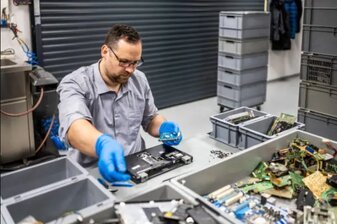In today’s technology-driven world, the performance of our electronic devices largely depends on the reliability of their batteries. Among various devices that we rely on daily, one common concern for users is when their device shows signs of a Tridyne low battery. Whether you’re dealing with a smartphone, a laptop, or any other device powered by a Tridyne battery, a low battery warning can be frustrating, especially if it happens unexpectedly.
This article delves into what it means when you encounter a Tridyne low battery, explores the symptoms associated with this issue, and provides effective troubleshooting tips to help you resolve it and ensure your devices perform at their best. If you’re facing the Tridyne low battery issue, rest assured, we have you covered!
What Is a Tridyne Battery?
Before diving into the troubleshooting and solutions for a Tridyne low battery, it’s important to understand the technology behind it. Tridyne is a prominent brand in the battery manufacturing industry, known for producing a wide range of power solutions for various electronic devices, including smartphones, laptops, power tools, and more.
Tridyne batteries are designed for high performance, energy efficiency, and reliability. They use lithium-ion or lithium-polymer technology, which allows them to be compact while providing a substantial amount of energy. However, like all rechargeable batteries, Tridyne batteries are not immune to performance degradation over time, which can lead to the dreaded low battery indicator.
Common Symptoms of a Low Tridyne Battery
A Tridyne low battery warning can manifest in different ways, depending on the device you’re using. The symptoms are often an indication that your device’s battery charge is getting low, but the warning can also signal other issues with the battery. Here’s what you might notice:
Battery Percentage Drops Rapidly: One of the most noticeable symptoms of a low battery is a sharp decrease in battery percentage. For example, you might start with 80% charge, and within minutes, it may plummet to 20%. This could be a sign of the battery’s inability to hold charge effectively.
Device Shuts Down Suddenly: Even if you have some battery percentage left, a Tridyne-powered device might shut down unexpectedly. This is often due to the battery not being able to maintain a steady charge.
Charging Issues: If you’re experiencing problems charging your device, such as the device not accepting a charge or charging at a much slower rate than usual, this could be a sign that your Tridyne battery is not functioning optimally.
Inaccurate Battery Level Display: Sometimes, your device may show incorrect battery readings, indicating a Tridyne low battery even though the device was charging for hours. This could point to a calibration issue or an issue with the battery itself.
Overheating: If your device feels unusually hot when using or charging, this could be an indication of a faulty battery. Overheating often occurs when the battery is old or damaged and cannot manage energy properly.
Why Does a Tridyne Low Battery Occur?
There are several reasons why a Tridyne low battery warning might appear, and it’s important to identify the root cause so that you can address it accordingly. Below are the most common causes:
Battery Degradation: Over time, all rechargeable batteries lose their ability to hold a charge. This is a natural process and is especially common in devices that are frequently charged and discharged. If your device is using an older Tridyne battery, it may be time to replace it.
Heavy Usage: If you’re using your device for resource-heavy tasks such as gaming, video streaming, or running multiple applications simultaneously, it can quickly drain the battery. Sometimes, what appears to be a low battery is simply due to excessive use.
Background Processes: Many devices run background processes that continue to use power, even when you’re not actively using them. Apps updating in the background, Wi-Fi or Bluetooth searching for connections, and location services all consume battery life without you noticing.
Environmental Factors: Extreme temperatures can have a significant impact on battery performance. Excessive heat can lead to overheating, while cold temperatures can reduce battery efficiency, leading to unexpected low battery alerts.
Faulty Charging Equipment: The charging cable, adapter, or even the port on your device can sometimes be faulty. If your charging equipment isn’t working properly, it can lead to your device not charging correctly, or it may take an unusually long time to reach full charge.
Software Issues: Sometimes, software glitches can cause inaccurate battery readings, leading to a Tridyne low battery warning even when your battery is not necessarily running low. In such cases, performing a software update or resetting your device might resolve the issue.
Troubleshooting and Solutions for Tridyne Low Battery
If you’re facing a Tridyne low battery, there are several steps you can take to troubleshoot and potentially fix the issue. Here are the most effective solutions to consider:
1. Recalibrate the Battery
Recalibrating your battery can help resolve issues where the device shows incorrect battery readings. To recalibrate, fully charge the device to 100%, then let it discharge completely until the device shuts off. Afterward, recharge it back to 100% without interruption. This process can help the device properly register the battery’s capacity.
2. Check Background Apps and Settings
If you’re experiencing rapid battery drain, check which apps or processes are consuming the most power. On smartphones, this can be done by accessing the battery settings, which typically show a breakdown of battery usage by app. Close unnecessary apps and disable non-essential background processes. Turning off features like Bluetooth, Wi-Fi, or GPS when not in use can also help preserve battery life.
3. Update Software
Outdated software can sometimes cause power issues. Make sure your device is running the latest software updates, as these often contain bug fixes and optimizations that can improve battery performance.
4. Change Your Charging Equipment
Sometimes, the issue may not be with the battery itself but with your charger. Try using a different charging cable and adapter to see if that resolves the issue. Also, inspect the charging port for dirt or debris that could affect the charging process.
5. Keep Your Device in Optimal Conditions
Avoid exposing your device to extreme temperatures, as both heat and cold can degrade battery performance. If you’re using the device in a hot environment or charging it while it’s in use, the battery may overheat, causing it to wear out faster.
6. Replace the Battery
If none of the above solutions work, it may be time to replace the Tridyne low battery. Most Tridyne-powered devices come with replaceable batteries, and it’s important to choose a genuine replacement to ensure compatibility and optimal performance. If you’re unsure how to replace the battery, consider taking your device to a certified technician for assistance.
7. Perform a Hard Reset
In some cases, software glitches can lead to a Tridyne low battery warning. Performing a hard reset or factory reset can resolve software issues that are causing inaccurate battery readings. Be sure to back up your data before performing a reset, as this will erase all data on your device.
Preventing Future Tridyne Low Battery Issues
To extend the lifespan of your Tridyne battery and avoid frequent low battery warnings, there are a few practices you can adopt:
Avoid Overcharging: While most modern devices are designed to stop charging once they reach 100%, it’s still a good practice to unplug your device once it’s fully charged to prevent unnecessary wear on the battery.
Charge Regularly: Instead of letting your device run down to 0%, try to keep it charged between 20% and 80% for optimal battery health.
Use Power-Saving Modes: Most devices have power-saving modes that reduce power consumption by limiting background activity and dimming the screen. Enable these modes when you’re trying to conserve battery life.
Replace Batteries Periodically: As batteries age, their capacity decreases. If you notice that your device’s battery performance is significantly degraded, it might be time for a replacement.
Conclusion
A Tridyne low battery warning can be a common yet frustrating issue. However, understanding the symptoms, causes, and troubleshooting techniques can help you resolve the problem quickly. By recalibrating your battery, monitoring background processes, and taking proactive measures to maintain battery health, you can extend the lifespan of your Tridyne-powered device and minimize future battery issues.
If the problem persists, don’t hesitate to consult a professional technician who can accurately diagnose and address the issue. With proper care and attention, you can continue to enjoy reliable and efficient performance from your Tridyne-powered devices for years to come.

